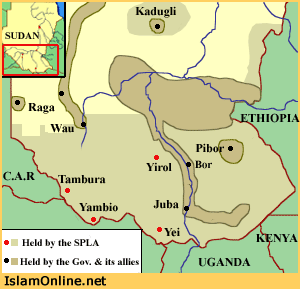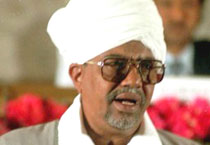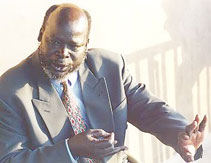|
The
Strategic Dilemmas of Sudan’s Peace Deal
|
Kareem
Mahmoud Kamel
Researcher
– International Relations
|
26/08/2002
|
 |
|
Map
of southern Sudan, reproduced from the National Democratic
Alliance
|
Throughout
history, there are defining moments that signify the beginning of an
era and the end of a previous one. Wars, revolutions, technological
breakthroughs and uneven growth rates between different societies were
usually thought of as harbingers of transformation and change in world
politics. However, peace agreements are another source of change. The
peace agreement between the Sudanese government and the Sudanese
People’s Liberation Army (SPLA), signed on July 20th in Machakos,
Kenya, following five weeks of marathon talks, resembles a landmark
transformation in both domestic Sudanese and regional politics.1
The
agreement, which was brokered by the Horn of Africa’s
Inter-governmental Authority on Development (IGAD), with the active
involvement of the United States, the United Kingdom, and Norway,
signifies an end to the 19 year-old civil war between the northern
government and rebels in the south which left more than 2 million
people dead and another 4 million homeless.2
Under
the terms of the protocol, southern Sudan will be granted a six-year
period of administrative autonomy and will not be subjected to the
Islamic law applied in the north. During the interim period, Sudan will
have two armies, the north under the leadership of the Khartoum
government, and the south under the leadership of SPLA leader, John
Garang. Also, the south will have the right to establish separate
administrative, security, and banking systems, and can pass laws that
suit the norms and traditions of the south.3
A
more controversial issue, however, is the provision that at the end of
the six years, animists, Christians and minority Muslims in the south,
will vote in a referendum on whether they wish to be part of Sudan or
secede.4 The clause reads as follows:
At
the end of the six (6) year Interim Period there shall be an
international monitored referendum, organized jointly by the Government
of Sudan and the Sudan People’s Liberation Army, for the people of
South Sudan to: confirm the unity of Sudan by voting to adopt the
system of government established under the Peace Agreement; or to vote
for secession.5
Currently,
talks are under way between the government and rebels to discuss issues
related to the relationship between religion and state,
self-determination, cease-fire arrangements, and distribution of
wealth. Despite optimism that the agreement can actually bring peace to
a war-torn Sudan, it masks a plethora of complex strategic and
geopolitical dilemmas. In this context, national security will be
understood as a multidimensional concept that not only involves
military/territorial threats, but issues of resource distribution,
water rights, and historical ethnic/cultural tensions. The case of
Sudan is a perfect example of the internal fragility of the Third World
state, the interconnectedness and overlapping between internal and
international politics, and vulnerability to regional and international
powers.6
The Historical Legacy of Conflict
 |
|
Sudan’s
beleaguered President Bashir
|
The
population of Sudan is almost 70% Muslim, mostly located in the north.
The remaining 30% of the population is either animist (25%) or
Christian (5%), and are mostly in the south.7
The population of southern Sudan is about 7 million, 65% of whom are
animist, 18% Muslim, and 17% Christian. There are almost 12 languages
with 250 different dialects, but Arabic remains the official and most
widely spoken language.8
Despite
the fact that Sudan gained its independence in 1956, the roots of the
north-south divide were planted long before by the British
colonialists. The territory of southern Sudan was demarcated at the end
of 1913 after a series of agreements between Britain, France and
Belgium, where the 10°N parallel was considered the line of demarcation
between north and south.9
More
importantly, Britain insisted on treating the south as an entirely
distinct area from the north. The Closed Districts Order of 1922 banned
non-southern Sudanese from traveling to or living in the South unless
they obtained a special permit. In addition, “Britain removed
northerners who had served in the southern administration, forbade
Arab-style clothes in the south, and taught English instead of Arabic
in the newly established schools. They also encouraged Catholic and
Protestant missionaries to open schools and churches, whereas they
banned Muslim schools, mosques, and preachers.”10
Hence,
suspicion between the north and south was already well established when
the country gained independence in 1956. Trends favored separation, as
southern politicians feared that when the country gained its
independence, it would be dominated by the wealthier and more
politically sophisticated northerners. In fact, just one month before
independence, the southern members of parliament refused to endorse the
independence proclamation unless the south was granted federal status.
The government then declared some commitment towards establishing a
federal system, but that was never implemented.
Essentially,
Sudan has been at war with itself since independence. However, there
was a period of peace between 1973 and 1982 due to the Addis Ababa
Accords, which were signed by the government, headed by Numairi, and
Anya Nya rebels, lead by Colonel Joseph Lagu. The accords provided the
south with a regional government, responsible for its own public order
and internal security, and local administration over social, economic,
and cultural matters. The south was also given its own assembly and
Higher Executive Council (HEC). The accord was embodied in the Regional
Self Government Act, which was incorporated into the constitution. It
stated that all citizens would be granted equal rights and any
discrimination on the basis of religion, race, language, or gender, was
to be prohibited.11
However,
the agreement was short-lived. By the early 1980s, Numairi made moves
that indicated his willingness to strictly control the country’s
political life. Political parties resisted his grip on power, and
worsening economic conditions lead people to riot in the streets. This
forced Numairi to align himself with religious-oriented groups in Sudan
as support for Islamic oriented groups increased, and to abrogate the
rights he had given the south. In 1983, after being elected (unopposed)
as president for a third time, he re-divided the south into separate
regions and decreed Islamic law for the entire nation. This lead to a
return to civil strife in the south, as southerners felt those recent
measures violated the essence of the Addis Ababa Accords.
The Politics of Oil & Water
Despite
its seemingly historical, sectarian and religious nature, the conflict
in Sudan has many economic, territorial and resource-based sources.
Moreover, it is not a purely domestic issue, but rather involves both
regional and international actors. In particular, the politics of oil
and water are increasingly important, as they are both vital resources
for both warring parties, as well as regional and international actors.
Sudan’s oil resources are estimated to be worth at least $53 billion at current prices.12 Some estimates put Sudan’s known reserves at 1.2 billion barrels, with another 800 million of recoverable reserves.13
One
of the SPLA’s first armed activities was targeted at the workers of the
oil company Chevron, which planned to construct an oil pipeline running
from the oil fields of the South to the refineries located in the
northern harbor of Port Sudan.14
The government is also accused of displacing large numbers of local
inhabitants to protect foreign companies’ oil operations. All those
measures indicate efforts by both opposition and government forces to
either control, protect, or destroy the oil production capacity. More
specifically:
Oil
is a symbol of the Sudanese problem: Sudan’s recent history of
decolonization, failed nation-building and its continuing political
affairs are reflected in the story of oil. Economic factors, such as
oil exploration and extraction, show not only that considerations of
the global economy dominate political decision-making but also clearly
indicate the underlying sources of conflict in Sudan.15
Also,
in light of the change in U.S. foreign policy after September 11th,
former “rogue” states, such as Libya and Sudan, are becoming
increasingly important for the U.S. in its bid to control the world’s
oil reserves. The U.S. is searching for oil-rich states without the
potential for massive conflict. Oil-rich Central Asia and the Gulf have
been riddled with conflicts for decades, and U.S. voters are not
comfortable with the idea of further domestic oil exploitation.16
The
U.S. has a stake in the current peace process in Sudan and in
reconciliation with Libya. In fact, “Libyan oil production already
ranks second to African oil giant Nigeria, and the Sudan when fully
explored by oil geologists, could eventually rival oil behemoth Saudi
Arabia.”17
In the words of John Danforth, U.S. special envoy to Sudan, “The
success of the peace talks in Kenya will transform Sudan from an area
of conflict to a major source of oil.”18
In
addition, China and the U.S. are engaged in fierce competition over oil
interests in Sudan. In fact, U.S. officials said that China is willing
to replace any firm that leaves southern Sudan. U.S. Assistant
Secretary of State, Walter Katsteiner, suggested that “We don’t foresee
anything stopping the Chinese from increasing their equity
participation in oil, and I think it probably would be problematic if
they were the dominant player.”19
The National Petroleum Corporation (NPC) – which is wholly owned by
China – already has a 40% share in oil extraction operations in Sudan.20
In
addition, Egypt has extensive interests in Sudan. The Egyptian response
to the Machakos agreement was very tepid, and many in Cairo voiced
concerns that the protocols laid the foundation for an independent
southern Sudan – an outcome that would stand in stark contrast to
Egypt’s national interests in a unified Sudan under Khartoum’s control.
Egyptian officials felt that the Machakos agreement bypassed the
Egyptian-Libyan Initiative (August 1999), and failed to recognize the
national interests of Egypt:
Any
Egyptian government, regardless of its ideological inclinations, has to
safeguard two things: national unity, and the unhindered supply of Nile
water… Any regional or international development that interferes,
however remotely, with either of these two imperatives inevitably
raises alarm in Cairo.21
 |
|
SPLA’s
Dr. John Garang
|
In
fact, the Nile remains the single most important facet of Egyptian
geopolitics, as without the river, Egypt would cease to exist. As early
as the 1970s, Egyptian Air Force bombers and reconnaissance aircraft
routinely patrolled Sudanese skies, and Egypt intervened militarily
several times in the 1980s against Libyan attempts to destabilize Sudan.22
There
is also the possibility of extensive Israeli activities in the Horn of
Africa, another source of alarm for Egypt. In fact, there is evidence
to suggest that there is intelligence and military cooperation between
Israel and both Kenya and Eritrea to curb the forces of so-called
“Islamic fundamentalism” emanating from the Sudanese government.23
Hence, the Machakos agreement raises the possibility of an independent
southern Sudan, with close U.S., and possibly, Israeli ties.
Conclusions
As
much as the Machakos agreement seems at surface to be an important step
towards ending the longest civil war in Africa, one must note that the
conflict involves a great deal of complex geostrategic relationships,
concerning a multitude of actors with many irreconcilable interests.
Hence, the whole issue must be put in its proper historical and
geostrategic framework, since it remains to be seen whether the
agreement will be a positive step towards reconciliation or a new
opening for further conflict and struggle. Either way, what is certain
is that the agreement will have major domestic, regional, and
international repercussions.
1-
For an in-depth study of theories of change see Robert Gilpin, War
and Change in World Politics (Cambridge: Cambridge UP, 1981); Barry
Schutz and Robert Slater, Revolution and Political Change in the
Third World (Boulder, Colorado: Lynne Rienner, 1990); Paul Kennedy,
The Rise and Fall of Great Powers (Connecticut: Fontana Press,
1986).
2-
Meron Tesfa Michael, “
Sudan
: Peace in Peril,” World
Press Review Online
August 7th, 2002
3-
Hassan Abu Taleb, “African Cloaks, Foreign Daggers,” Al-Ahram
Weekly Online
August 8th, 2002
.
4-
Nevine Khalil, “Concerned Support for
Sudan
Deal,” Al-Ahram
Weekly Online
August 8th, 2002
.
5-
“Machakos Protocol,” United
States Institute of Peace Library: Peace Agreements Digital
Collection: Sudan
July 30th, 2002
.
6-
For a theoretical view on
Third World
conflict and national security, see Bahgat Korany et al., The Many
Faces of National Security in the Arab World (St. Martin’s Press:
New York, 1993)
7-
“
Sudan
: Reference Document” World
Press Review Online
8-
Hisham Al-Hadidi, “
Southern Sudan
…Where To?” Al-Ahram Daily
August 4th, 2002
: 12 (in Arabic).
9-
Ibid.
10-
Ann Mosely Lesch, “The Republic of Sudan,” in Tareq Y. Ismael
and Jacqueline S. Ismael, Politics and Government in the Middle East
and North Africa (Florida University Press: Miami, 1992): 362.
11-
Ibid., 369-370.
12-
Meron Tesfa Michael, “
Sudan
: Peace in Peril.”
13-
Franz Schurmann, “‘Rogue’ No More – US Eyes Oil in
Libya
,
Sudan
,” Pacific News
June 18th, 2002
.
14-
“Sudan:
Oil in Sudan – Deteriorating Human Rights,” Amnesty
International
May 3rd, 2000
.
15-
Ibid.
16-
Franz Schurmann, “‘Rogue’ No More – US Eyes Oil in
Libya
,
Sudan
,” Pacific News
June 18th, 2002
.
17-
Ibid.
18-
Hisham Al-Hadidi, “
Southern Sudan
…Where To?”
19-
“
China
Eyes Greater Oil Stake in
Sudan
,” World Tribune
June 11th, 2002
.
20-
“Sudan:
Oil in Sudan – Deteriorating Human Rights,” Amnesty
International.
21-
Hassan Abu Taleb, “African Cloaks, Foreign Daggers,” Al-Ahram
Weekly Online
August 8th, 2002
.
22-
Rick Francona, “The
Nile River – The Politics of Water,”
Suite
101
August 28th, 2001
.
23-
Israel
Shahak, Open Secrets: Israeli Nuclear and Foreign Policies (London:
Pluto Press, 1997): 68-71.
|